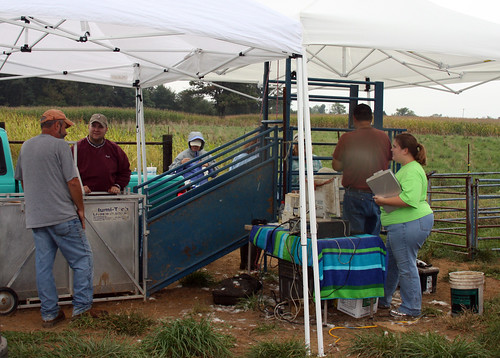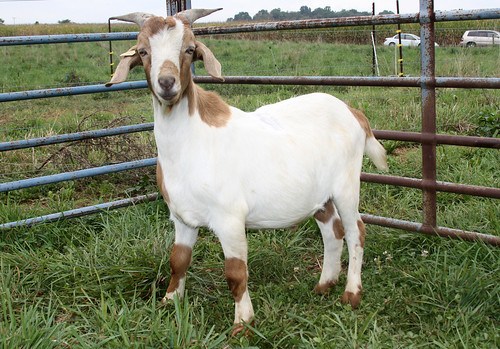From August 29 until September 12, average daily gains ranged from -0.286 to 0.500 lbs. (-130 g to 227 g) per day for an average gain of 0.126 lbs. (57 g) per day for the 58 goats on test.
The top-gainer for the period was a Kiko cross buck consigned by Don Smith (VA). Several consigners had goats that gained 0.357 lbs. (162 g) per day: Don Smith, Terry Hankins, (MS), Pam Adams (MD), Mark Sweitzer (PA), Merritt Burke (DE), Andrew Miller (IL), and Bill Lowe (PA, 2).
 While the gains were better than the previous 2 week period, in which the goats lost an average of almost two pounds, it was disappointing that 7 goats failed to gain any weight and another 11 goats lost 1 to 4 lbs. It is not always easy to understand why some goats gain weight and others lose weight, despite appearing healthy.
While the gains were better than the previous 2 week period, in which the goats lost an average of almost two pounds, it was disappointing that 7 goats failed to gain any weight and another 11 goats lost 1 to 4 lbs. It is not always easy to understand why some goats gain weight and others lose weight, despite appearing healthy. For the 84-days of the test, ADG is ranging from -0.048 to 0.265 lbs. (-22 to 120 g) per day for an average of 0.140 (64 g) for all of the goats. Two Kiko bucks are tied for having the highest rate-of-gain. John Smith (VA) and Kendell Barnes (KY) are the consigners. Bucks consigned by Don Smith and Terry Hankins (MS) are tied for having the second highest rate-of-gain at 0.253 lbs. (115 g) per day.
FAMACHA© scores were greatly improved, ranging from 1 to 3 for an average of 1.81. Goats with FAMACHA© scores of 3 (n=9) were dewormed with levamisole drench (3 ml/50 lbs.). Levamisole was used because of its shorter withdrawal time. We are nearing the end of the test and some of the goats will be going to slaughter.
 Two weeks ago, 27 goats required anthelmintic treatment. The poorer FAMACHA© scores were consistent with the August 29 fecal egg counts which ranged from 171 to 14,375 eggs per gram and averaged 3,998 epg (the highest counts yet).
Two weeks ago, 27 goats required anthelmintic treatment. The poorer FAMACHA© scores were consistent with the August 29 fecal egg counts which ranged from 171 to 14,375 eggs per gram and averaged 3,998 epg (the highest counts yet).Fecal samples collected from the treated goats will show the effectiveness of the treatments administered on August 29 (moxidectin), though improved FAMACHA© scores already give an indication that treatments were effective at improving packed cell volumes.
Additional data was collected today. Jim Pritchard from West Virginia University scanned the goats for backfat, body wall thickness, and rib eye area. The scan data will be posted to the blog in a few days. For goats that are slaughtered, the scan data can be compared to the carcass data to determine the accuracy of scanning.
A scrotal tape was used to measure the circumference of each goats' testes. In other species, minimum standards have been established for scrotal size. In goats, we are still in the process of collecting data, though it makes sense to favor bucks with larger testicles.
 Teats were counted and abnormalities noted in the records. The goats were mouthed to determine the correctness of their bite. Over and undershot jaws were noted. After handling, the goats were placed in an 8 ft. x 8 ft. pen where they could be observed for structural soundness. Abnormalities were noted. All of this data will be combined into a supplemental report.
Teats were counted and abnormalities noted in the records. The goats were mouthed to determine the correctness of their bite. Over and undershot jaws were noted. After handling, the goats were placed in an 8 ft. x 8 ft. pen where they could be observed for structural soundness. Abnormalities were noted. All of this data will be combined into a supplemental report.
The final work day will be Monday, September 29. Final data will be collected at this time and the bucks will be grouped and/or ranked on the basis of their performance: growth rate, parasite resistance, and parasite resilience. The top 20 bucks will be eligible to sell on October 4.
The goats currently have access to most of the paddocks. The forage is plentiful. Temperatures are cool. Hopefully, the goats will put on some meaningful gains over this final weigh period.











